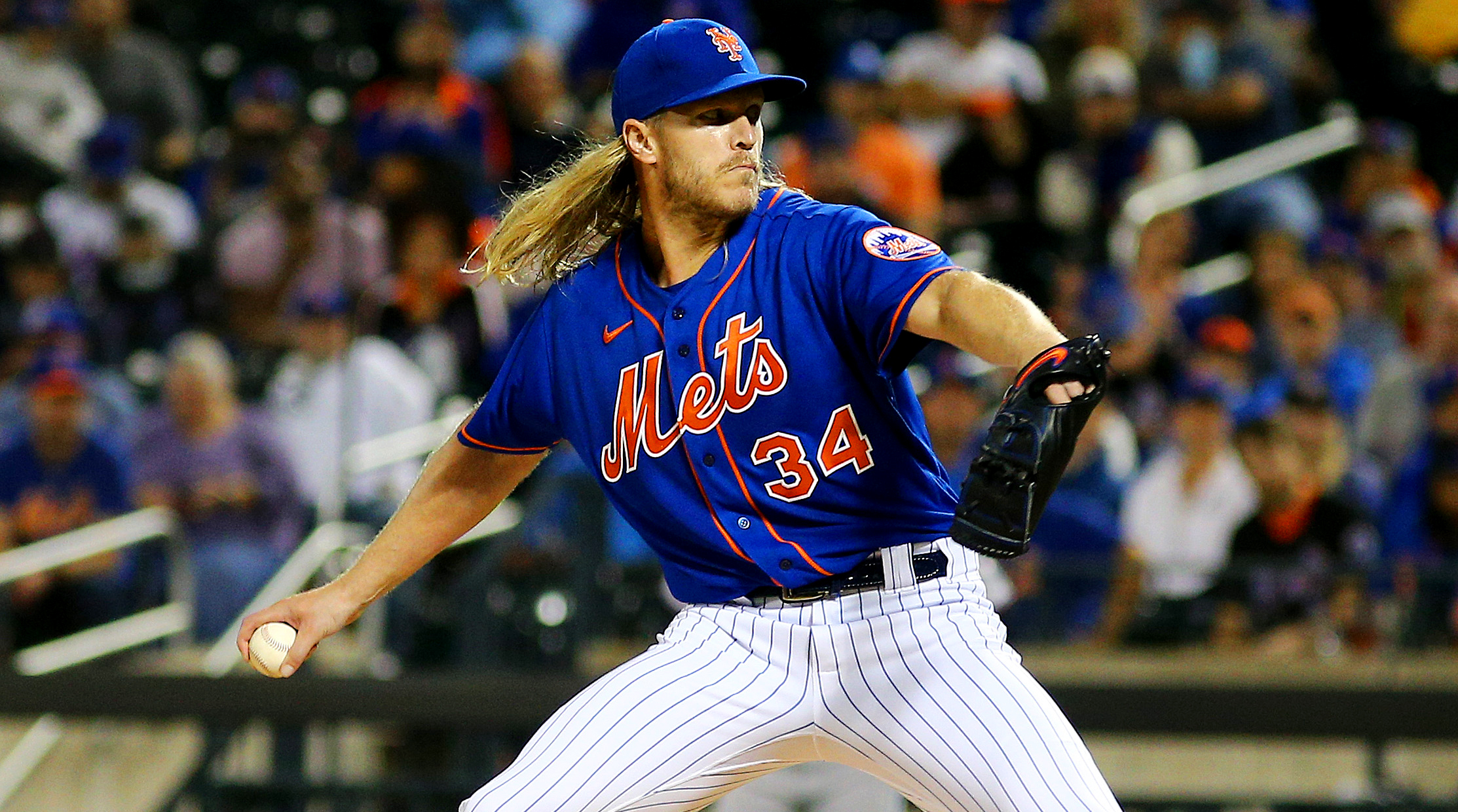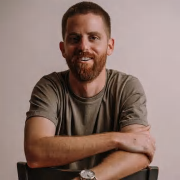Thor Gets a Halo... Now What?

In his quest to end the franchise’s seven-year postseason drought, Angels general manager Perry Minasian took his first big step of the offseason by reportedly agreeing to a one-year, $21 million deal with starting pitcher Noah Syndergaard. One move alone does not address the club’s glaring need to overhaul its pitching staff, but it could signal the first in a series of acquisitions that finally get a team with Shohei Ohtani and Mike Trout into the postseason.
The Angels pitching staff has performed like a ship taking on water for years. Every offseason they try to to plug holes, and every season, the deluge only seems to get worse. They have attempted to address their pitching shortcomings with bargain bin-type additions like Matt Harvey, José Quintana, Trevor Cahill and a host of other low-end, past-their-prime arms, only to end up treading water or sinking further below the surface. Signing Syndergaard represents a whole different type of risk—one that, if it pays off, could be the catalyst that helps shake them out of their current stasis.

The Angels have made no secret their goals for this offseason, which are centered around bolstering a pitching staff that has ranked in the bottom half of the league for the better part of a decade. Angels starters ranked 22nd in ERA last season (4.78), 28th in walk rate (9.0%) and pitched the fifth-fewest innings, averaging fewer than five frames per start. The team hasn’t ranked in the top half of the league in starting pitching ERA since 2017, and hasn’t finished in the top 10 in that category since 2011.
That’s a long history of ineptitude to overcome, and they’ll need more than Thor to substantially improve their 2022 prospects, especially because there is some risk in the signing. Syndergaard, 29, has the profile of a No. 1 starting pitcher. He throws two fastballs, a four-seamer and sinker, that sit in the upper 90s and max out above 100 mph, and he has three above-average secondary pitches (slider, changeup, curveball). He's built, at 6'6" and 240 pounds, and owns a 3.32 career ERA. The problem is he's managed just two innings over the last two seasons while recovering from Tommy John surgery. There are justifiable concerns about durability and rust in his first year back. A one-year prove-it deal seemed like the best he was going to get, the only question being whether he'd accept the Mets' $18.4 million qualifying offer or sign elsewhere for more money.
Make no mistake, the Angels are taking a risk in this deal, considering they are paying $21 million and losing a second-round draft pick (given as compensation to the Mets because Syndergaard turned down the qualifying offer) for a pitcher who has thrown only two more big league innings than me over the past two seasons. How much of a concern is his health? Consider Eduardo Rodríguez, who’s also entering his age-29 season and on Monday signed with the Tigers for five years and $77 million after posting a 4.74 ERA over 157 2/3 innings in 2021. Rodriguez’s FIP (3.32) and xERA (3.50) suggest he pitched better than his results, but the total value of his contract still far exceeds Syndergaard's deal.
That said, this is a risk the Angels needed to take because of their dire need for impact arms. Betting on Syndergaard to return to his old ways two years after Tommy John surgery might seem like a wise gambit because of their recent experience with a similar scenario. Ohtani underwent the same procedure following his rookie season in 2018. After not pitching at all in 2019, he faltered in an abridged 2020, retiring just five of the 16 batters he faced across two outings before shutting things down again with a strained right flexor.
Ohtani put all those concerns to bed in 2021 with a dominant showing on the hill, striking out 156 batters over 130 1/3 innings with a 3.18 ERA. His average fastball velocity returned to 95.6 mph, not quite the same as his rookie season (96.7) but still 28th among qualified pitchers. Syndergaard is also a power pitcher with a similar profile to Ohtani, and the Angels are likely confident that he’ll look more like his old self with the procedure even further in the rearview mirror.
For Syndergaard, the move makes sense from a few different angles. The righthander likely preferred a one-year deal to reestablish his value before hitting the market next winter. Despite their struggles, the Angels clearly are trying to win now and not waste Ohtani and Trout’s prime years any further, so Syndergaard at least has the potential to pitch in meaningful games down the stretch and possibly into October. They opted to use a six-man rotation to alleviate Ohtani’s workload last year, and it's expected they'll do the same thing again in 2022 to accommodate both Ohtani and Syndergaard.
The Angels reportedly have around $40 million left in the 2022 budget after adding Syndergaard, per Sam Blum of The Athletic, so there’s still room to acquire an impact arm or two. The team made a qualifying offer to closer Raisel Iglesias, who has yet to decline or accept the deal. (The deadline is Wednesday at 5 p.m. ET.) If he accepts, that’s another $18.4 million of payroll to one of the best relief pitchers in the game, which is great, but it leaves them with fewer resources to address their starting rotation unless they want to blow past their budget and the luxury tax threshold. (Granted, this is all assuming baseball's financial structure remains the same in the new collective bargaining agreement.)
That rotation currently consists of Ohtani, Syndergaard and a pair of young lefthanders, Patrick Sandoval and José Suarez, who both impressed last season. Sandoval finished the year on the injured list with a lower back stress fracture, but that isn’t expected to impact his availability for spring training. There are other in-house options, though most are inexperienced and relatively unproven, including Jaime Barria, Griffin Canning and former first-round pick Reid Detmers.
The Angels have only three players with guaranteed salaries beyond the 2022 season: Trout, Anthony Rendon and David Fletcher, so there is some long-term flexibility even with Trout and Rendon each signed through at least 2026. They probably want to use that flexibility to extend with Ohtani, who is due to become a free agent after the 2023 season. His future cost is hard to define because of his unique role as a two-way player, but it is sure to be significant. That leaves them in a precarious position. They need to do whatever they can to upgrade their pitching so they can win now and make Ohtani want to stay, but they also need to be careful not to blow all their financial resources ahead of time so they can have enough money to afford him.
That means more short-term deals for high-upside pitchers could be in store, though none will be as young as Syndergaard. Justin Verlander, Zack Greinke and Corey Kluber could all be options of this type, as well as Rich Hill and James Paxton. The offseason is still in its early stages, but the amount of money given to Rodriguez and former Angel Andrew Heaney signals that the market for pitching is going to be quite competitive. Given the degree to which the Angels desperately need pitching, acquiring high-end talent was never going to be feasible without paying a little extra for some additional risk.
Syndergaard is not the singular answer to the Angels’ woes. But, depending on the next chess moves, he could be the foundation upon which a life raft can float.
More MLB Coverage:
• Syndergaard's Signing Signals an Active Market for Starters
• Tigers State Their Intent With a Savvy Signing
• Rankings and Predictions for MLB's Top 50 Free Agents
• Relief Pitching Is Out of Control
